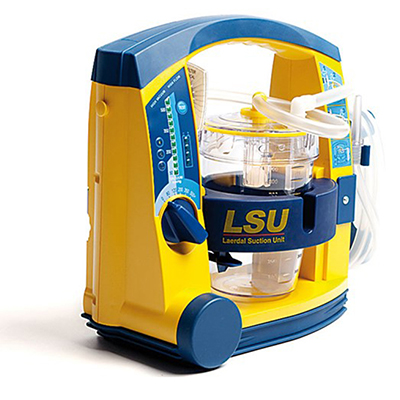Long before companies designed EMS suction machines, healthcare providers still had to protect their patients’ airways. Many turned to makeshift suction devices—especially when tending to patients in remote and chaotic locations, such as on the battlefield where airway management is at a premium but still highly important for the patient and medic alike. Eventually manual suction units such as Potain’s aspirator were invented, but it was cumbersome to use and not a highflow device.
Airway suctioning is a routine part of a first responder’s job. From preventing aspiration pneumonia to clearing the airway of a drowning victim, the right suction machine is an integral part of your EMS toolkit.
What is an EMS Suction Unit?
A suction machine, also known as an aspirator, is a type of medical device that is primarily used for removing obstructions—like mucus, saliva, blood, or secretions — from a person’s airway. When an individual is unable to clear secretions due to a lack of consciousness or an ongoing medical procedure, suction machines help them breathe by maintaining a clear airway for maximum air flow. In practice, care professionals use suction machines as an important part of a treatment plan when a patient’s airway is partially or completely obstructed. Common brands and types include: the Laerdal Suction Unit (LSU), Laerdal Compact Suction Unit (LCSU 4), S-SCORT III, and V-Vac, a manual suction pump.
EMS Suction Units and How They Work
Portable suction machines generate negative pressure, which is channeled through a special type of plastic connecting tube called a single-use catheter. The negative pressure creates a vacuum effect that pulls any blood, mucus, or similar secretions out of the throat. The secretions are then automatically dispensed into a collection jar. Users can select a continuous or intermittent suction mode and adjust the level of suction to ensure all secretions are being cleared. In order to generate negative pressure and remove secretions, portable suction machines rely on a few key technologies. These machine components include: connective suction tubing, suction/vacuum pump, disposable/rechargeable batteries, sterile patient tubing, regulator, suction pump, suction catheter, disposable canister system, suction canister, vacuum regulator, filters, the device diagnostics and the adapter and dc power cord and battery charger.
Other Areas Suction Units Are Used
Home Care
Patients may require portable suction machines in their home if they are unable to clear their own secretions for a variety of reasons. This includes patients who are receiving palliative care and find it difficult or impossible to clear their own secretions, individuals with chronic illnesses (COPD, ALS, cystic fibrosis, bronchiectasis, other oropharyngeal and tracheal issues), pediatric patients, or patients who have undergone a tracheostomy.
Pre-Hospitalization
Portable aspirators are very common in a pre-hospital setting, as they play a crucial role in helping emergency responders establish ABC (airway, breathing, and circulation). In practice, pre-hospital providers often use portable suction machines to treat a variety of patients. This includes trauma victims with blood in their airway, overdose victims with vomit in their airway, and other victims that are experiencing a respiratory emergency.
Inpatient Care
Most hospitals have rooms that are outfitted with stationary, wall-mounted suction machines. Care teams often use stationary aspirators as a part of standard procedures such as tracheostomies, sinus-related ailments, and tonsillectomies. However, hospitals often have a few portable devices for certain use cases. For example, if a patient needs an aspirator but there is no wall-mounted aspirator in the patient’s room, the care team will locate and retrieve a portable aspirator instead of moving the patient to another room. Additionally, they’re used to treat patients outside of a room when hospitals are at capacity.
How To Clean EMS Suction Units
A suction machine has many parts, so frequent cleanings are an absolute necessity. Ideally, medical professionals should clean an aspirator after every use while wearing personal protective equipment to protect against hazardous waste, and then clean the reusable parts in regular intervals to ensure the aspirator and its components are free of dangerous contaminants. The good news is that many aspirator parts are single use.
Consult your product manual to determine what can be reused and what should be disposed of after use to maintain the warranty. Make sure all single-use parts are disposed of in accordance with hospital and local protocols for medical waste. For regular cleaning, wipe down the unit’s housing and vacuum port with a damp, soapy cloth, and then dry it with a lint-free cloth. To disinfect after use, dampen a cloth with a 10% bleach solution and thoroughly clean the housing and vacuum port, taking care to ensure no liquid gets inside the aspirator. Finally, ensure the aspirator is completely dry before storing or reusing it.
What Not To Use
There are some compounds that should not come into contact with a suction machine. Do not allow grease or oil to enter the system or coat the reusable components of your aspirator, and do not expose the inside of the aspirator to excessive amounts of water. Additionally, avoid using hydrocarbon or abrasive cleaners on your suction machine, as they may damage the casing or components. Always refer to your aspirator’s product manual or cleaning instructions to confirm that your device has been cleaned properly.
Penn Care Suction Units
Penn Care is your trusted source when it comes to portable EMS suction units. We offer manual, portable and automatic suction units of many different sizes and classifications. If you’re in the market for an EMS suction unit, call Penn Care today to see what we have available in our extensive inventory. We stock some of the industry’s most trusted brands, and we’re more than happy to help guide you through your purchase!



